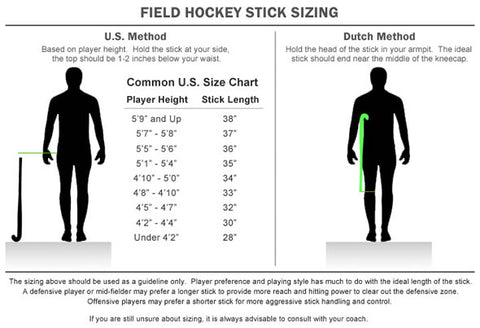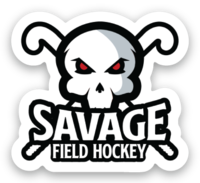FAQ's
What stick should I choose?
How to choose the right stick for YOU Basic criteria for stick selection is:
- Player height.
- Level of play.
- Player preference.
- Budget.
Composite sticks
Composite sticks are produced with different materials molded together. Each composite stick has an individual matrix formula to maximize its power, strength, feel and durability. Each stick from the mold will be exactly the same.The stick should be well balanced and should feel good in your hands. The weight in head should still allow you to have maximum stick speed when maneuvering and hitting the ball.
Reinforcing Materials
Player Height
Generally most players play with a 36.5 inch stick, Junior players may select sizes 36 and below. Sticks from 37.5 inch and higher are mainly used by taller players or due to player preference.
Stick Weight
Weight is quite important when choosing a stick. Generally the weight of a stick is classified as
BOW: All composite sticks have a bow from the handle to the toe, which cannot be greater than 25 mm. The bow, or rake as it is also known is the amount of curvature along the playing surface of the stick from the top of the handle to the base of the head of a hockey stick. The amount of bow is measured by placing the hockey stick face down on a flat surface and measuring the maximum distance between the surface and the playing surface of the stick.
Most have a standard bow measuring about 24 mm but some sticks are incorporating a "late/low bow". This means that the center of the bow has moved down the shaft towards the head of the stick. This shift increases ball control and allows for a better ability to lift the ball. This type of bow tends to help players from the midfield up to the front line. Defenders usually prefer a more standard bow. This change to the rules was deemed necessary in response to the development of the drag flick technique for short corner routines, Internationals were regularly producing ball speeds of up to 140kph. This in turn led to a number of well publicized injuries resulting in the FIH's decision to take action and reduce the maximum bow allowed.
Advantages of Increased Bow:
Slingshot effect:
As the ball is propelled along the shaft of the stick it builds up speed so that when it leaves the end of the stick it is traveling faster than the speed of the head of the stick (if the technique is executed properly). This technique can be used on both a horizontal plane with the stick parallel to the ground (for passing or drag flicking) or a vertical plane with the stick at right angles to the ground (for aerial passes). Without going into a full explanation of the drag flick technique it is difficult to explain the benefits of increased bow. In general terms it enables the individual to build up initial speed over an increased distance without the ball slipping off the head, provides more energy into the ball in the desired direction of travel and due to the fact that so much of the ball speed is generated at end of the motion a greater level of control (and disguise) is/can be created.
Disadvantages of Increased Bow:
Hitting & Passing:
Due to the curvature of a hockey stick with an increased bow, the stick will come into contact with the ball sooner and at a different angle than with a straight or less bowed stick. Depending on the angle of the stick when attempting to strike or pass the ball two different effects are likely to occur. Striking the ball with the stick in a vertical position (i.e. at right angles to the ground) the ball will lift off the ground to a varying extent, depending on the power imparted to the ball. Striking the ball with the stick in a horizontal position (i.e. with the stick parallel to the ground) will cause the ball to move in a direction left of the intended target. Striking the ball with the stick in any position in between is likely to cause the ball to lift and and move in a direction left of the intended target, depending on the sticks angle and the power imparted to the ball
Receiving on the Reverse Side:
When receiving a ball on your reverse stick side, the tendency is to lean the leading edge of the stick towards the ball in order to trap it and instantly gain more control. With a hockey stick with an increased bow when you lean the leading edge of the stick towards the ball the bowed element of the shaft raises further off the ground sometimes leading to the ball slipping underneath the shaft of the stick.
Level of Playing:
Irrespective of whether you play for high school or university you have to take into consideration how often you play or practice as you will be using the stick a lot more than anticipated. It may be a good idea to go for the higher price range of sticks, which has stronger materials resulting in better performance.
These are just general guidelines to help you make your decision, however it all depends on personal preference. If you have any other questions about this topic or any field hockey equipment please email us.
- Player height.
- Level of play.
- Player preference.
- Budget.
Composite sticks
Composite sticks are produced with different materials molded together. Each composite stick has an individual matrix formula to maximize its power, strength, feel and durability. Each stick from the mold will be exactly the same.The stick should be well balanced and should feel good in your hands. The weight in head should still allow you to have maximum stick speed when maneuvering and hitting the ball.
Reinforcing Materials
- Fiberglass is the basic material reinforcing the handle. It adds strength and durability.
- Carbon or Graphite add stiffness to the handle. The more experienced player can take advantage of the increased hitting power without it having an adverse effect on their receiving skills.
- Kevlar adds strength, while also dampening the vibration. The added flexibility allows for more control and feel when hitting or receiving
Player Height
Generally most players play with a 36.5 inch stick, Junior players may select sizes 36 and below. Sticks from 37.5 inch and higher are mainly used by taller players or due to player preference.
Stick Weight
Weight is quite important when choosing a stick. Generally the weight of a stick is classified as
- Light - weighing 17oz - 20oz. The light stick allows faster stick movement; if you rely on your skill to beat an opponent and are not too concerned about hitting the ball at high speed, then consider lightweight.
- Medium - weighing 21oz - 22oz. The Medium sticks are good for hard hitting out of the defense. If you are a midfield or a defender, consider using a medium weight stick.
BOW: All composite sticks have a bow from the handle to the toe, which cannot be greater than 25 mm. The bow, or rake as it is also known is the amount of curvature along the playing surface of the stick from the top of the handle to the base of the head of a hockey stick. The amount of bow is measured by placing the hockey stick face down on a flat surface and measuring the maximum distance between the surface and the playing surface of the stick.
Most have a standard bow measuring about 24 mm but some sticks are incorporating a "late/low bow". This means that the center of the bow has moved down the shaft towards the head of the stick. This shift increases ball control and allows for a better ability to lift the ball. This type of bow tends to help players from the midfield up to the front line. Defenders usually prefer a more standard bow. This change to the rules was deemed necessary in response to the development of the drag flick technique for short corner routines, Internationals were regularly producing ball speeds of up to 140kph. This in turn led to a number of well publicized injuries resulting in the FIH's decision to take action and reduce the maximum bow allowed.
Advantages of Increased Bow:
Slingshot effect:
As the ball is propelled along the shaft of the stick it builds up speed so that when it leaves the end of the stick it is traveling faster than the speed of the head of the stick (if the technique is executed properly). This technique can be used on both a horizontal plane with the stick parallel to the ground (for passing or drag flicking) or a vertical plane with the stick at right angles to the ground (for aerial passes). Without going into a full explanation of the drag flick technique it is difficult to explain the benefits of increased bow. In general terms it enables the individual to build up initial speed over an increased distance without the ball slipping off the head, provides more energy into the ball in the desired direction of travel and due to the fact that so much of the ball speed is generated at end of the motion a greater level of control (and disguise) is/can be created.
Disadvantages of Increased Bow:
Hitting & Passing:
Due to the curvature of a hockey stick with an increased bow, the stick will come into contact with the ball sooner and at a different angle than with a straight or less bowed stick. Depending on the angle of the stick when attempting to strike or pass the ball two different effects are likely to occur. Striking the ball with the stick in a vertical position (i.e. at right angles to the ground) the ball will lift off the ground to a varying extent, depending on the power imparted to the ball. Striking the ball with the stick in a horizontal position (i.e. with the stick parallel to the ground) will cause the ball to move in a direction left of the intended target. Striking the ball with the stick in any position in between is likely to cause the ball to lift and and move in a direction left of the intended target, depending on the sticks angle and the power imparted to the ball
Receiving on the Reverse Side:
When receiving a ball on your reverse stick side, the tendency is to lean the leading edge of the stick towards the ball in order to trap it and instantly gain more control. With a hockey stick with an increased bow when you lean the leading edge of the stick towards the ball the bowed element of the shaft raises further off the ground sometimes leading to the ball slipping underneath the shaft of the stick.
Level of Playing:
Irrespective of whether you play for high school or university you have to take into consideration how often you play or practice as you will be using the stick a lot more than anticipated. It may be a good idea to go for the higher price range of sticks, which has stronger materials resulting in better performance.
These are just general guidelines to help you make your decision, however it all depends on personal preference. If you have any other questions about this topic or any field hockey equipment please email us.
Field Hockey Stick Sizing

